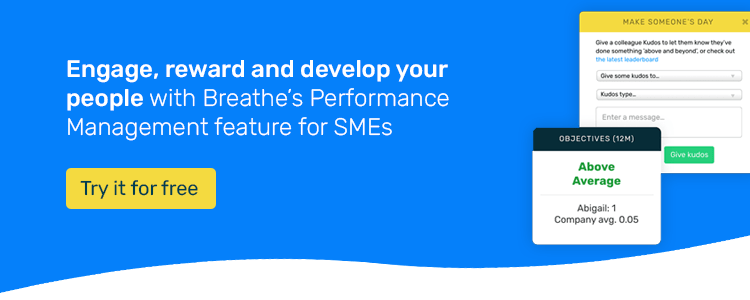Most of us think of conflict as a bad thing.
But, have you ever stopped to consider that there are two kinds of conflict? It can actually be healthy as well as unhealthy.
When used well and managed, conflict improves outcomes for your team by challenging the status quo and pushing them to think differently. In this sense, we’d agree that healthy conflict is generally a good thing.
But unhealthy conflict? Now that’s a different situation entirely.
Hugely damaging to your organisation, reputation and company culture, negative conflict is bad news for any small business' overall productivity.
In this article, you'll learn:
- 6 ways conflict kills productivity
- 4 useful tips to help you nip conflict in the bud
6 ways conflict kills productivity
Left unresolved, negative office conflict can create big problems for small businesses. And here's how.
It causes stress
Conflict is a major cause of workplace stress and, if left unresolved, can lead to long-term health issues, time off work and absenteeism (one of the dreaded ‘toxic triplets’).
Frequent and unresolved conflict can also indicate a toxic workplace culture - and you’ll want to address this if you want your business to grow and thrive.
It causes disruptions
From avoiding certain team members to obstructing each other’s tasks, conflict is a drain on your team’s time and disrupts employees from working together effectively.
It wastes managers' time
One study shows that UK businesses spend around £33 billion each year on resolving workplace conflict and waste an estimated 370 million working days as a result.
Can your business afford that?
It damages relationships
The damage conflict causes is rarely limited to those who disagree with one another.
Let conflict drag on and you’ll notice team members taking sides, creating divisions in your business and killing productivity as a result.
It affects employee retention
If a member of your team is clashing significantly with another colleague, it’ll lower their job satisfaction and morale - and could even lead to them handing their notice in and finding another job. And high employee turnover definitely doesn’t go hand-in-hand with productivity.
Equally, workplace conflict can potentially affect your reputation and your ability to get talented candidates through the door in the first place.
It damages your customer experience
Customers will pick up on a chilly atmosphere faster than you can say 'icicle'.
And, if a particular employee has had a row with a team mate and they’re not really enjoying work at the moment as a result, it's bound to be reflected in the service they provide to your customers.
This could potentially mean your customer retention and sales take a hit.
4 tips to nip conflict in the bud
The best way to prevent unhealthy conflict affecting your business is by nipping it in the bud before it gets out of hand. But this doesn’t need to be taxing - here are 4 simple things you can do to stop conflict becoming a problem in your small business.
-
Set clear expectations
Make sure your team knows what is and isn’t acceptable. Clear (but reasonable) boundaries equate to happier teams.
By creating clear workplace guidelines and setting out what is and isn't acceptable behaviour, you banish the grey areas where issues fester.
From the language you use, to your hours and the way in which your team are expected to complete their work, by clarifying your expectations everyone knows where they stand.
And these expectations don’t need to be decided by the leadership team alone - agreeing your values as a business can help your team bond, help them feel valued and enhance your company culture.
A study by Modern Survey suggests that employees who know and understand the values of their company are a staggering 51 times more likely to be engaged at work.
-
Build strong communication channels
Conflict and poor communication often go hand in hand.
Taking the time to encourage open communication will pay dividends when it comes to conflict. By checking in regularly and ensuring the team are all on the same page, you’ll be minimising any miscommunication and potential arguments that could come as a result.
Communication is key for strong leadership, too. Regular feedback helps your people develop and your business succeed. Instead of limiting feedback to your employees’ performance reviews, make it part of the everyday conversation. It’ll also give your people a chance to vent their concerns and address any niggling issues that could lead to conflict.
To prevent ‘feedback’ becoming an opportunity to openly criticise, encourage a focus on forward-thinking development. You might also find this podcast a useful listen – it focuses on turning conflict into something positive.
-
Minimise workplace stress
There’s no denying that stressed employees can be more sensitive and up-tight, meaning the likelihood of conflict with other team-mates can increase.
Our research shows that, in the last year, long term health conditions including stress were the culprit for 62% of health-related absences among SMEs.
So, it’s important to take a temperature check. How stressed are your team? What’s making them stressed? What you currently have in place to minimise stress? What else you can do to help?
Things like ensuring your people have a work-life balance, regulating workloads and avoiding micro-management all help towards minimising stress - and therefore conflict.
Our mental health in the workplace guide provides some valuable tips on how to tackle the work-related triggers of stress and mental health.
-
Hire for cultural fit
The people you hire are your business.
So, it makes sense to ensure they work well together. Remember: skills and qualifications are only part of what makes a candidate suitable for a role; you must also think about their cultural fit.
It’s a balancing act, though – you need enough variety in your team to keep it vibrant and productive, but you should avoid people who could potentially damage your team’s dynamic.
Understanding candidates’ values and how they align with your company is a step towards hiring the right person. You’ll be able to ensure they fit in with the team and that they will help to prevent friction rather than fuel it.
.webp)
Author: Sarah Benstead
Sarah is a Product Marketing Specialist here at Breathe. Always innovating, she loves writing about product releases in an engaging & informative way. When she's not coming up with new ideas, she enjoys long walks with her dog, Clifford.





